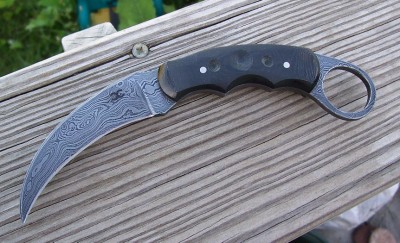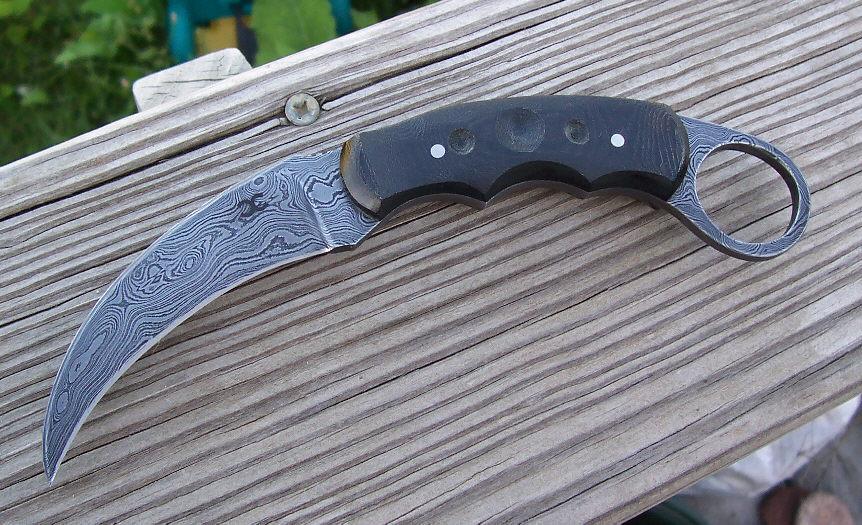
First, let me just say that going armed is a serious responsibility. It is not cliché at all to say that it is a matter of life and death. It doesn’t matter if it is a knife, a gun or a plastic Spork that you have sharpened into a prison shank, the responsibility is the same. When you carry a deadly weapon, you commit yourself to meeting deadly force in kind, and you shoulder the responsibility of recognizing when restraint should be exercised. Legally and morally speaking, you don’t want to be caught out on the wrong side of a bad decision where deadly force is concerned.
On a personal note, I always feel calmer when armed. It has been said that an armed society is a polite society, and I think it is true. Things that really make me mad when not armed roll off when I am. The possibility of deadly force puts things in perspective, and there are very few things in life that make it worth going there.
So, why might one choose to carry a knife rather than a gun for self-defense? There are some instances where the choice makes sense. If I am going to be banking or frequenting locations that prohibit firearms, I will often opt for a blade rather than a handgun. It is important to note that many state and local laws look at certain knives in the same light as guns in terms of being a concealed weapon; this includes double-edged daggers and fixed blades over a certain length. However, most businesses that prohibit concealed carry specify firearms rather than weapons in general. An edged weapon can be a nice loophole in these instances, but be aware of and in compliance with all applicable laws. I never rely solely on a knife when in a high-threat environment, but realize that in the times we live in there is virtually no such thing as a zero-threat environment.
How To Defend Yourself And Your Family Against The New Breed Of Lowlife Criminal Scum
A knife, like any other weapon, should never be used as a deterrent. Drawing and brandishing your blade is assault with a deadly weapon if it isn’t justified, and it is only justified if there is a credible threat to life and limb. Presenting any weapon in any other circumstance is a very bad idea. It seldom mediates and often escalates a situation, and it makes you the aggressor. Concealed weapons serve one purpose and one purpose only — to eliminate a threat when all other reasonable means have failed to preserve your own life or the life of other innocents (like your kids). If it’s just about a wallet, let ‘em have it; I have never had enough in my pocket to justify killing or injuring someone, no matter how low that someone may be.
Once you have decided that you are facing a credible threat, actions must be swift and violent. This is even more critical with a knife than with a gun. The last thing you want to get into is a knife fight. Helpful hint: In a knife fight almost everyone gets cut, good guys and bad guys alike. When the blade clears leather, your one goal is to eliminate a threat, quickly and decisively. Warnings at this point only give your adversary a chance to prepare. If the blade is out, conversation has already failed.
Law enforcement has long been taught the “20 foot Rule.” This rule states that if you are facing an assailant with a knife at 20 feet or less, and your weapon is not already drawn and aimed, the guy with the knife stands a good chance of getting to you before you get him. Coincidentally, CCW training generally involves qualifying with a pistol at 7 yards, one foot beyond the magic 20-foot barrier. This is the line in the sand, if you haven’t gotten the bad guy by this mark you might not get him. This is not all bad news. The flip side is that if you are the guy with the knife, you still have a chance of taking out an adversary armed with a gun. Making that charge will take nerves of steel and a level of determination that will only come with a lot of adrenaline and a healthy dose of desperation. This is not something you would do unless you are certain that you or a loved one will be killed otherwise, but the option is there with a chance of success if the need truly arises. This is not something I would do to save a wallet or a car (even a really sweet car!), but definitely would if one of my kids’ life is on the line.
For personal defense, I choose knives with fixed blades. As I have said, when a knife comes out it is time for immediate and violent action. There isn’t a lot of shock and awe in fumbling with the blade of a folding knife. Assisted open knives may be a good option, it has just been my experience that mechanical devices have a tendency to fail at the worst possible time. There is nothing to go wrong with a fixed blade knife.
I have recently taken a shine to Karambits. I am coming to think that this style of knife is uniquely well-suited to personal defense. I am tempted to proclaim the Karambit the perfect defensive blade, but that is a very subjective matter. The perfect knife is a very individual choice. If someone were to tell me that they thought the Kissing Crane Leg knife was the best defensive knife ever I wouldn’t argue the point, although that person has got to be nuts!
Ultimate Tactical Self-Defense And Hunting Weapon That Doesn’t Require A Firearms License!
I like the Karambit for several reasons. First and foremost is the finger hole at the end of the handle. With your pinky or index finger through the hole there is very little chance that you will drop your weapon, no matter how sweaty and shaky they become. I also like the curved blade, perfect for broad sweeping cuts. Finally, the Karambits are a lot of knife in a compact package. The shape means you get more edge in less overall length, and these knives are very easy to conceal and carry.
Although there is plenty of training and technique available for the Karambit, it is a very intuitive weapon to use. With a reverse grip, index finger through the finger hole and blade protruding from the bottom of the fist, if you know how to throw a punch you are good to go. In the standard grip, pinky through the finger hole and blade protruding from the top of the fist, you have a very effective slashing and slicing weapon. In this context, there is no finesse or grace required; you are a horror movie slasher plain and simple. On a more developed tactical note, the Karambit is well-suited to incapacitating the hands. Grasp your opponent’s wrist with your off hand and with your knife in the reversed grip slice through the forearm severing the tendons and ligaments that control the hand and fingers. If you find yourself on the ground the same thing can be done to the Achilles tendon, bringing your adversary down. All of these tactics work with other styles of knife as well, for my tastes though, the Karambit is particularly well-suited to the task.
Whatever knife you choose, realize that it is a tool first. If all goes well you will never need to draw your blade in defense. There are, however, about 150 occasions on the average day where a good knife is needed for a mundane task. In this regard, a knife is a better choice than a gun. If, however, you are going into a high threat situation, go with the gun. You don’t want to show up with a knife at a gun fight but, with a little prep, don’t count yourself out if it should happen.
